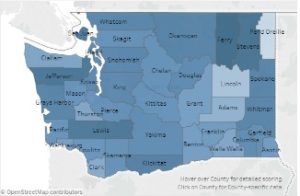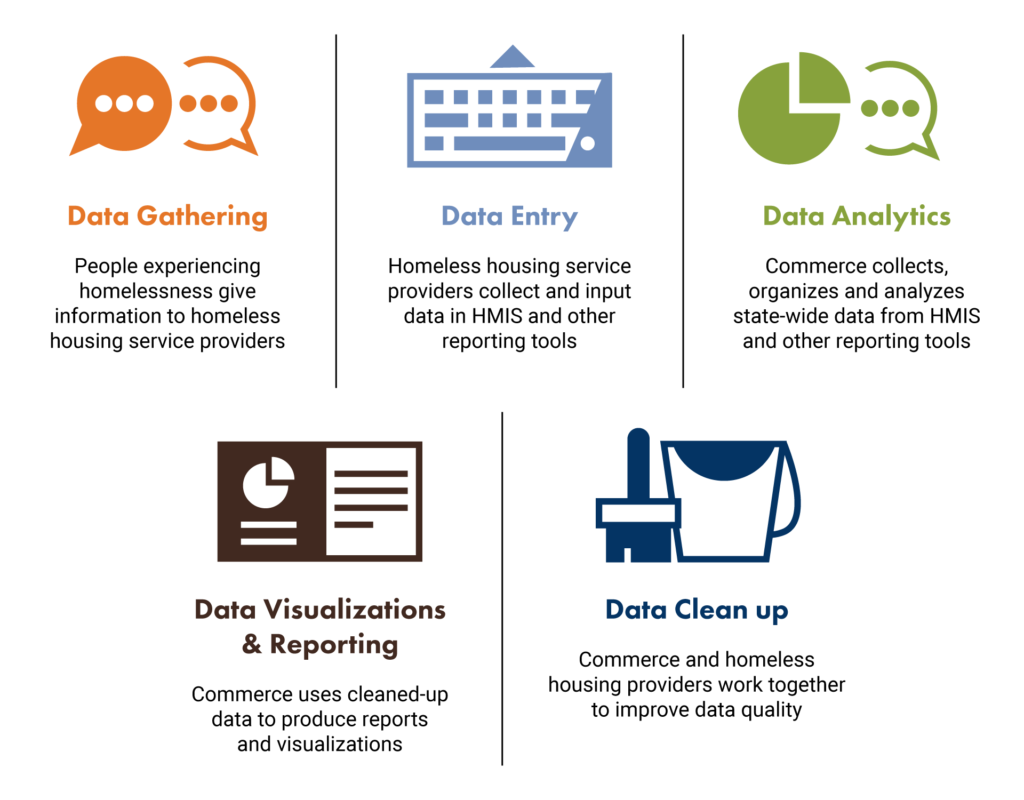Homeless System Performance
Performance measures help evaluate the effectiveness of homeless crisis response systems as they work to ensure that homelessness is rare, brief and one time.
Homeless System Performance Measures
The Department of Commerce identifies the following as the most critical homeless system performance measures:
- Prioritizing unsheltered homeless households
- Increasing exits to permanent housing
- Reducing returns to homelessness
- Reducing the length of time homeless
New rental assistance and homeless system performance measures:
New state funding sources were passed into law following the 2021 legislative session. These funds aim to prevent evictions by providing resources to households most likely to become homeless, suffer severe health consequences, or both, after an eviction. Additionally, funds prioritize households disproportionately impacted by public health emergencies, homelessness, and housing instability. Learn more about rental assistance and homeless system performance measures.
The web-based Data and Performance Unit for the Housing Division public portal provides one-stop information on homelessness assistance, spending, and performance.
For more information on the homeless system performance measures that Commerce reports or requires, please review the Homeless System Performance Measures Crosswalk (PDF).
Washington State Homeless System Performance Reports
Published annually, the County Report Card and Year to Year Comparison provide performance outcome results for Washington and each county. Data from all homeless housing projects that participate in HMIS are included in these reports.
Washington State Homeless System Performance Reports are available on Tableau. Unfortunately, Tableau does not support versions 8, 9 and 10 of Internet Explorer. If you have problems viewing the reports, try using Chrome, Safari or Firefox browsers.
The County Report Card
 The County Report Card provides information for the state and each county on system-wide performance measures, including exits to permanent housing, returns to homelessness, length of time homeless, and cost per exit to permanent housing. The County Report Card is embedded in an interactive map, which allows you to review performance outcome results for the reporting period. Click on the Trend Data button to access an interactive table that allows you to see trends over time. It also includes contextual information such as PIT Count results and rental vacancy rates.
The County Report Card provides information for the state and each county on system-wide performance measures, including exits to permanent housing, returns to homelessness, length of time homeless, and cost per exit to permanent housing. The County Report Card is embedded in an interactive map, which allows you to review performance outcome results for the reporting period. Click on the Trend Data button to access an interactive table that allows you to see trends over time. It also includes contextual information such as PIT Count results and rental vacancy rates.
Dashboards
Published quarterly, dashboards provide performance, data quality and equity information for counties, agencies and project types. At this time, only counties that are included in the Balance of State Continuum of Care are included in project-type dashboards.
Performance Reports Purpose and Use
The Homeless System Performance Reports aim to promote evidence-based housing interventions that efficiently move people experiencing homelessness into permanent destinations and improve county data reporting. These system goals are outlined in the Homeless Housing Strategic Plan (PDF).
Additionally, these reports provide communities with information regarding their progress toward locally established performance benchmarks.
Because each community has established performance benchmarks using local baseline data, comparing the performance outcomes of different counties is not appropriate.
Performance Reports Data Sources
Homeless Management Information System (HMIS)
The Homeless Management Information System (HMIS) is the data source for most of the information used in our performance reports. Homeless housing service providers use HMIS to collect and manage data gathered while providing housing assistance to people experiencing homelessness.
Other Sources
Annual County Expenditure Report (The Golden)
Each county in Washington reports all expenditures by funding sources for each homeless housing project in their community. Commerce combines expenditures data with HMIS data to create The Golden Report, found on the State Strategic Plan, Annual Report and Audits page.
Annual Point-In-Time Count (PIT)
Each county in Washington conducts an annual point-in-time count of sheltered and unsheltered homeless persons. The census is conducted in accordance with the requirements of the Department of Housing and Urban Development. The PIT Count takes place in January.
HEARTH Homeless System Performance Measures
Please refer to the HUD reporting specifications and HUD CoC performance training videos for detailed information about HEARTH Homeless System Performance Measures.
Commerce Reporting Specifications
- Washington Balance of State Rapid Re-Housing Performance and Data Quality Reporting Specifications (PDF)
- Washington Balance of State Temporary Housing Performance and Data Quality Reporting Specifications (PDF)
- Washington Balance of State Homelessness Prevention Performance and Data Quality Reporting Specifications (PDF)
- Washington County Report Card Reporting Specifications (PDF)
- Consolidated Homeless Grant (CHG) Performance Tracker Reporting Specifications (PDF)
- Washington Balance of State Equity Analysis Dashboard Reporting Specifications (PDF)
Equity Analysis Tools
National research from SPARC shows that people of color are dramatically more likely than White people to experience homelessness. The Washington Equity Analysis Tool compares the Point in Time Count to American Community Survey data to help communities analyze racial disparities among people experiencing homelessness. The Washington Equity Analysis Tool is based on HUD’s CoC Analysis Tool.
Washington Equity Analysis Tool
Note: You will need to click the Download button to view and use this tool.
The Washington Balance of State Equity Analysis Dashboard looks at racial and ethnic disparities in the homeless system from entry to exit. It uses a rate of entry that normalizes the subpopulations and also provides additional performance indicators to drill down at the county or regional level.
Program Links
- Consolidated Homeless Grant
- Annual Point in Time Count
- Continuum of Care
- Emergency Solutions Grant
- Tenant-Based Rental Assistance (TBRA)
- HUD Section 811 Rental Assistance
- Homeless Student Stability Program (HSSP)
- Homeless Management Information System (HMIS)
- Homeless System Performance
- Office of Homeless Youth
- Homeless Councils
- Homeless Services Grantee Training
Resources
Contacts
Emily Burgess, Managing Director, Data and Performance Unit
Email: Emily.Burgess@Commerce.wa.gov
Phone: 360-764-6200
Andrea Arteaga, Performance Manager
Email: Andrea.Arteaga@Commerce.wa.gov
Phone: 206-600-0638
Jayme Khoo, Data Analytics Team Manager
Email: Jayme.Khoo@Commerce.wa.gov
Phone: 360-742-2600
Performance Specialist (Coordinated Entry)
VACANT
Sarah Harrison, Performance Specialist (Youth and Young Adults)
Email: Sarah.Harrison@Commerce.wa.gov
Phone: 360-463-0216
Makela Alem, Performance Specialist (Racial Equity)
Email: Makela.Alem@Commerce.wa.gov
Phone: 564-669-3792
Alexa Price, Training & Technical Assistance Manager
Email: Alexa.Price@Commerce.wa.gov
Phone: 360-819-6054

